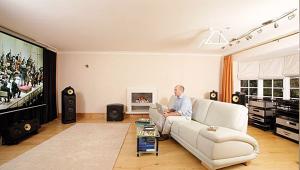Ken Kessler
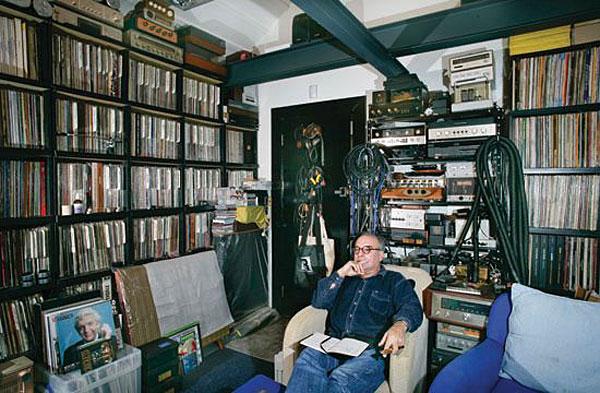
Ever wondered how reviewers built up their systems, and what their rooms are like? And how did they develop their reviewing techniques? Welcome to the listening room of the most influential and certainly the most entertaining writer in audio: Ken Kessler.
If Aladdin had been an audiophile, his cave would have looked like this. Ken Kessler's listening room has become legendary among hi-fi enthusiasts, so we thought it was time to take you there. Ken has been writing for Hi-Fi News since 1983, but of course, his passion for audio goes way back before his professional involvement.
Back in the 1950s, my dad was an amateur tape recordist, and he used to swap tapes with people around the world, Glenn Miller bootlegs and other big-band stuff. He wasn't an audiophile as we know it. He spent all his money on a decent tape-recorder, it was a big-ass Concord open-reel. He made his own mixer, and next to it he just had an RCA record player.
'But when I first got into hi-fi, it wasn't because of my dad. A friend of mine's father owned a furniture store, and in those days, companies like Fisher in the US would sell hi-fi consoles – they were high-end audio, serious stuff – but fitted into decent furniture. He had an all-Fisher system, but with a Dual turntable. And I immediately fell in love with the Dual turntable.
'Another friend, whose father actually owned a rival furniture store, had a system that consisted of a Rek-O-Kut turntable, AR speakers, I can't remember the amplifier, but again it was high-end stuff
'So I had friends whose families had decent kit. When I hit 16, in 1968, and started working and had a little bit of money, I bought a Scott 344C receiver, a Dual 1019 deck with a Pickering cartridge, and a pair of small Scott two-way bookshelf loudspeakers, which would have been around the size of a KEF Coda.
'That system cost $700, and if you look back at what $700 was 42 years ago, it was a ton of money! I remember giving a deposit and taking a couple of years to pay it off, at $7 a month or something. It was certainly a serious investment for a 16-year-old kid.'
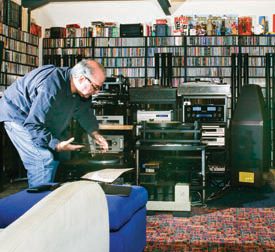
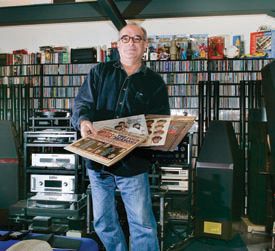
MUSIC FIRST
'That was because I loved music. I'd already had, from the age of 13, a record player, and fortunately, my father had taught me how to handle records. Also, mono was still available and most of my records were mono, but any stereos that I had bought prior to that were the first of the stereo-compatibles, so I didn't ruin any of them.
'And I'll never forget that the first record I ever played on that system was The Who, "Pinball Wizard," on a single, which I believe was one of the very first stereo 45rpm singles.
'When I got to university, and I really got hit by the hi-fi bug, I combined my gear with my roommate's system, and that carried me through the first two years. The third year I was in England, but when I went back to the US, I had an apartment with the friend whose father owned the Fisher system.
'Again, we pooled our systems. He had a Marantz four-channel receiver, I had a pair of ESS Tempests, which were used at the rear, and he had a pair of the ESS speakers with Heil tweeters that were used at the front. And I had sold the Dual and picked up a Pioneer PL12D, which was the hot turntable at that time.
'Then I decided to move to the UK, so all of that was left at home in the States. When I got to England, I was broke, and I was living in a B&B. So I got another Pioneer PL12D which I fed into a Teleton integrated amp, which was all I could afford! It was OK, because I was only using it as a headphone amp, and it didn't start to distort until it went over the level needed for the headphones, which were Sennheiser HD414s.
'Later I started working in hi-fi retail, but before that I bought a Rogers Cadet valve amp and a pair of Goodmans Eleganzia speakers, which I picked up for something like a tenner. But then a friend of mine, Geoff Richardson, who played in Caravan, sold me a Radford STA25.
'I worked in retail for three years. I didn't really pick up much kit then, because I was listening to old valve equipment, and we were selling new gear, and there wasn't anything really that I needed to change in my home system. But I did buy a pair of Radford Tristar 90 speakers, which I wish I had back now!'
THE WRITE STUFF
By then Ken had already made contact with the world of magazines, and, as it turned out, with the publisher of Hi-Fi News, which in those days was Link House Magazines in Croydon.
'I'd started writing freelance for Custom Car in 1976, so I was going back and forth to Link House. And I actually met Paul Messenger before I started writing about hi-fi. I went upstairs to Hi-Fi News from the offices at Custom Car, because Paul was selling off a Rega Planar 2.'
Later, when Link House decided to launch a new "younger" audio magazine alongside Hi-Fi News, Ken's ebullient style was just what it wanted, and the company hired him as a full'time staff writer. 'So I got out of hi-fi retailing and went to work for Stereo: The Magazine in 1982 and 1983. Long before there was a T3 and a Stuff, Stereo was trying to do the lifestyle gadget thing. Because Link House didn't know what they had, they just let it die. Which was stupid! Stereo folded, but then HFN/RR editor John Atkinson picked me up to go straight over to Hi-Fi News.'
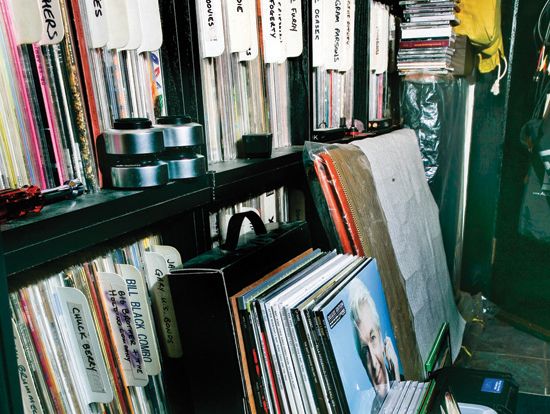
HOME WITH THE CLASSICS
Among Ken's first contributions were the "Anachrophile" features on vintage equipment. 'All along, I'd been going to junk shops and buying vintage kit, any old crap really, because I just loved it. I had a huge collection of my own vintage gear anyway. I already had a system I could review from, as I was using the Radford amp with the Tristar 90s and I'd gone from the Rega 2 to a Trio (Kenwood) KD500 with SME arm.
'And through the years, I honestly cannot even begin to count how many pieces of equipment have been through my listening room.
'In fact, I had three rooms prior moving into this house in 1995. When I started out in the UK, I just had a tiny 12 by 12ft front room. This was before hi-fi writing, before hi-fi retail, when I was working in a bookshop. When I was in hi-fi retail, we bought our first house, which was a terrace.
'Because the house was too small for reviewing, I rented space in an industrial unit, and I actually had one of the best listening rooms you could imagine. But I was subletting it from Sound Ideas, and they grew so quickly that they needed the space.'
Then, in 1995, Ken and his wife moved into their present house, and Ken set about putting in the listening room he has now. 'It's been optimised to have no coloration in the bottom end, no resonances, so that the room is as neutral and hi-fi friendly as can be, and I am listening to the system and not to the room.
'The room was wired with four brands of audiophile AC cables in four different rings, plus one of standard house wiring as a control. There are 42 AC mains sockets on the four rings, which are connected into their own consumer unit, isolated completely from the house, even with separate billing.'
Ken's multiple mains installation gave him a unique opportunity for cable comparison. He could amaze visitors by sitting them down to hear the differences when the CD player, for example, was fed from the consumer unit via Siltech, or Transparent, or ordinary copper.
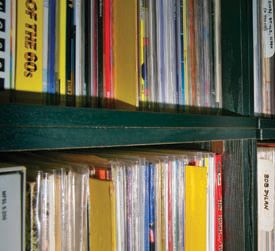
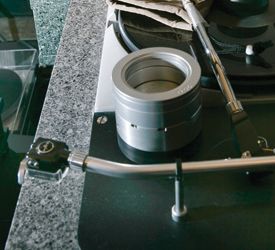
HI-FI HIGH POINTS
Switching on the listening room, Ken says, was a high point in his career. But there have been many others. 'Over the years I've had such remarkable pieces. In fact, if you look at what I've had over the years its quite frightening! The longest-serving system I ever had was Krell monoblocks with Apogee Scintillas. I also had 200W Classé monoblocks with the Apogee Divas. And I had an Oracle turntable for the longest time.
'I stayed with Apogees until Apogee folded. Because my policy is, with three exceptions – and the exceptions are the LS3/5A, Decca cartridges and the Marantz CD12/DA12 – that I try my best only to review with stuff that is in current production. Since the demise of Apogee, I have always used, with very few breaks, Wilson speakers. I had WATTs up to generation 7, and now I'm using Sophias.
'Once I got the listening room, I always went for stability, and people know that I stick with stuff for a long, long time. My permanent reference is the CD12/DA12, strictly because it's the best CD player that I've ever heard. But people know that I always use a second player with it. So I've got a recent two-box Musical Fidelity, and a Quad 99. So I'm not just using something that's no longer available.
'But the biggest constant for me over the years though, has been the LS3/5A. I have listened to LS3/5As never less than 20 hours a week, because I have a pair on my desk.
'When we did the LS3/5A shoot-out [HFN, June -01], to me it was the most valuable review I'd done, because it was the only time that all of those really rare and even unique models had been assembled under one roof. No-one else had ever been able to do it, or could have done it. So to me, that was a really special moment. But the biggest review of my career was the three-way we did on the Apogee Scintilla [HFN, Sep '85], which was me, Atkinson and Colloms. That was just a phenomenal piece.
'An eye-opener for me of course, was the SME Model 30 review [HFN Nov '90]. Since the launch of the 30 I've been a staunch SME user. Another milestone that was a fantastic review for us was the McIntosh "anniversary" 275 amp, the Gordon Gow Commemorative [HFN, Nov '93]. Before that, McIntosh had really gotten short shrift in the UK.
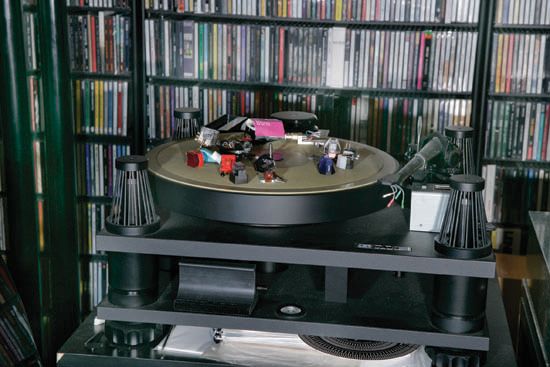
'Another bombshell was the Marantz T1 [HFN, Jan '97], you remember that monoblock with all the tubes on top, from Ken Ishiwata? And, I would have to say, the first Koetsu Urushi [HFN, April '90]. It just did things that made it the closest to the Decca. Magical. And I enjoyed when we did the old Linn LP12 versus the newest LP12 [HFN, Oct '97]. That was an amazing review that we did as a group. And more recently, obviously, reviewing the Continuum turntable, at Michael Fremer's house in the US.'
FUTURE FORMATS
'New technologies? I just take them as they come. Because vinyl hasn't gone away, because they haven't shut FM down yet, and because CD is still with us, I don't feel that I've been coerced into embracing the streaming/download culture.
'Now, I don't have a problem with it, and I do download a lot of FLAC recordings, especially from Wolfgang's Vault and now from HD Tracks, which Chesky Records opened up. And I enjoy them. But psychologically, I still like to have a physical carrier, I like to have a disc or a tape to put on. But if the editor sends me, say, a Benchmark or whatever, I can go into my high-end system and I've got all the music on the hard drive in my netbook.
'Another thing is, I never had an issue over new formats. I embraced home theatre from the get-go, for the simple reason that I love movies. Nothing to do with "us and them" or movies being more important than music. I consider them to be equally important. Because motion pictures are an art form, so to say that one is better than the other is wrong.' But you ended up thinking that it was better to have a separate cinema system, rather than trying to integrate it with the hi-fi?
'Keep them separated! The home theatre is in the family room. But, it's a high-quality system. I'm now using a huge Rotel receiver driving five Martin Logans. I use that system if I'm doing multichannel SACDs. If I'm doing two-channel SACDs, they go into the high-end room.
'But if I'm reviewing software that's got a surround component to it, for example in my digital pages, I can review anything. In fact I've just got a surround-sound disc of Eric Clapton's Crossroads Guitar Festival, and it's a four-hour DVD. That I will review in the home theatre system.'
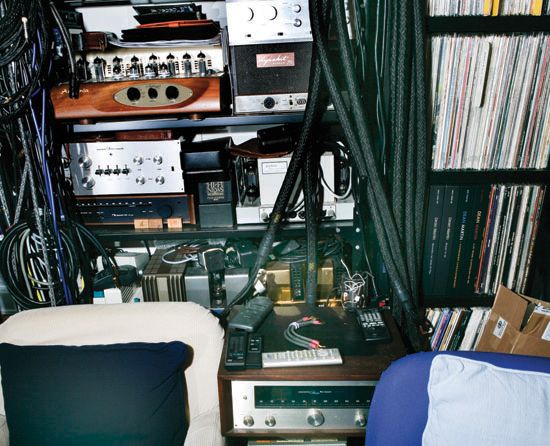
TRUST YOUR EARS
Though he has many visitors, Ken doesn't regularly involve other listeners in his reviewing. 'No, because I hate being influenced by the zeitgeist. If everyone in the room is in love with something I think sounds dire, I may question my own reactions. Conversely, if I love something everyone in the room hates, I wonder if they're right and I'm wrong. I trust my own ears.' And does he think that first impressions are usually right?
'Absolutely. Offhand, I can't even name five products over the years which "grew" on me after long'term listening to a point that completely reversed the initial sensation. But you have to qualify that with "assuming the stuff is warmed up and sensibly matched", or the first impression is valueless.'
And isn't there is a big difference between listening to, say, a new high-end speaker with the benefit of vast experience, and listening to the same product as a newcomer?
'The problem for the "newbie" is no frame of reference, so it's easy to be overwhelmed by the evident superiority over previous speakers the individual may have heard, and think all is wonderful. Equally, for the newcomer, there are no preconceptions, so the reaction is the best of all: a gut reaction.
'For the seasoned listener – especially reviewers who have their own prejudices – it's the reverse. The seasoned listener can be more analytical and detached, because he or she is "used" to such performance. The downside is pre-conditioning or prejudice. For example, I know I approach horns in a negative mood, and electrostatics in an up mood.
'The best speaker I've ever heard, to this day, is the Apogee Scintilla ribbons. But they're fragile now, I don't have amps that will drive 'em, I haven't fired them up in a while, they're too big for my room. They're there in my dreams that I win the lottery and get myself a room like the SME listening room.'
STILL A CHALLENGE...
'But this is the message that I'd give to any reader who's putting together a system and evolving with it: if you find something you love, enjoy it. Don't buy something because a salesman told you to, or because I told you to. Buy it because it sings to you, and you like it.
'We are all entitled to create our own references. And my references are based on which products sound the best for the parts of the music which for me are the most important ones.
'Now that sounds crazy. You should want it to be optimised for everything. But we all know, categorically, that no hi-fi has yet managed to convince, in a 100% foolproof manner, that you're listening to reality.
'In fact, I was with a friend and audiophile the other day, we were walking down the high street in Canterbury, and there were three buskers playing congas. We just looked at each other and he said, "There isn't a hi-fi in the world that can reproduce that power!" And, of course, he was right.
'In this respect I'm not a glass-half-empty kind of guy. I don't consider it a negative. I consider it fun, and it's the challenge of hi-fi. If there was a perfect hi-fi, there be no need for hi-fi magazines or critics, you'd just buy that hi-fi. If everything was perfect, I'd be out of a job!'

THE LISTENING ROOM

This room was painstakingly constructed as a dedicated listening studio, as Ken explains: 'The walls are 18in thick, consisting of 9in outer brick wall, 1⁄2in insulation with damp course, then 9in cinder block. As for the floor, this is 1m of poured concrete, with underfloor heating. The walls are plastered, but aren't visible because there is symmetrically arrayed shelving. This doesn't cause reflections because it's LP spines in the back half of the room, while the front of the room is surrounded by CD storage. Meanwhile, the pitched ceiling is high enough not to affect the sound.'
